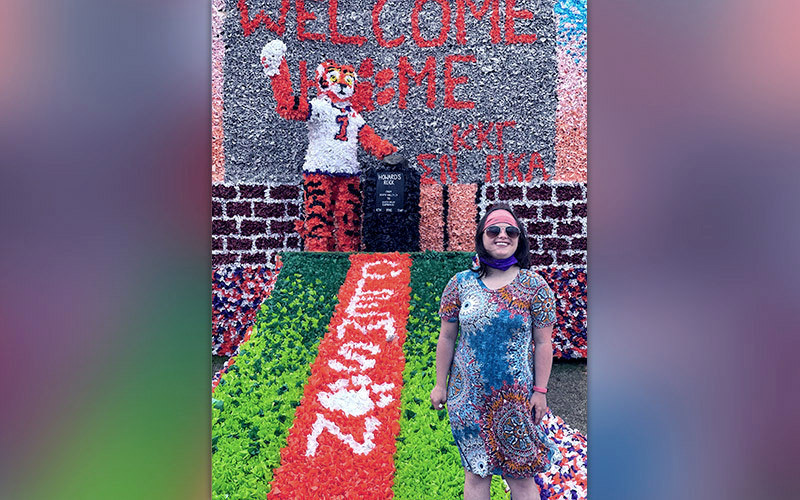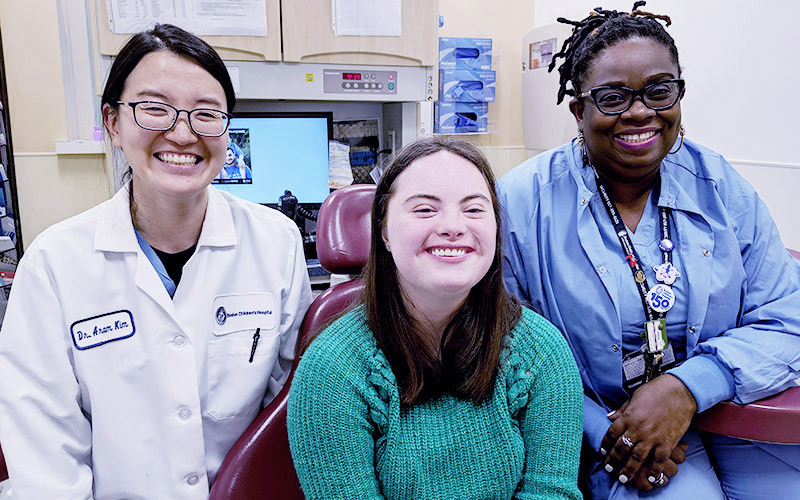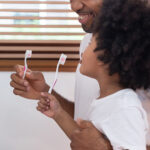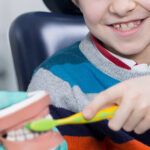Amanda gets the smile she always wanted — just in time for college

One of the first things you’ll notice about Amanda Altemus is her big smile.
She’s a proud Clemson Tiger and excited to talk about how she is in the university’s post-secondary education program for students with intellectual disabilities. When she’s not studying, she loves rooting for the Clemson football team, watching YouTube videos, and listening to music.
It’s an exciting time for the 21-year-old, but Amanda didn’t always feel comfortable sharing that big smile. She was missing some teeth and had a bite that didn’t function properly. By the time Amanda was 11, her teeth had severe wear patterns and she was conscious of her appearance. She needed a long-term dental plan, rather than relying on advice from separate specialists.
Searching for the proper path forward
Amanda had several dental features that are common among people with Down syndrome: a short upper jaw, underbite, missing teeth, and short tooth roots.
She wore braces in fifth grade, but her bite was soon misaligned again because her teeth had shifted and several adult teeth had yet to surface. She eventually had some baby teeth removed and underwent jaw surgery to allow the impacted adult teeth to emerge. With those stages of work complete, her parents were ready to search for comprehensive dental treatment that would give her a functioning bite and a smile she would be proud of.
Amanda and her parents, Dawne and Chris, didn’t have to search far. Dawne was familiar with Boston Children’s Hospital, for years accompanying Amanda to appointments coordinated through the Down Syndrome Program. At various times in Amanda’s life she has been treated by the Department of Neurology; Division of Gastroenterology, Hepatology, and Nutrition; the Orthopedic Center; and the Sleep Center.
It made sense, Dawne recalls, to turn to the hospital’s Department of Dentistry. “We had great experiences with all those specialists and we appreciated how they work as a team,” Dawne says. “I knew if anyone was going to fix this, it would be Boston Children’s.”
Suggesting treatments that best suited Amanda
Even though Amanda’s teeth were misaligned, Marc Ackerman, DMD, director of the Orthodontics Program, thought she shouldn’t wear braces again because the tension they cause would have done more harm than good to her upper teeth. He instead had her briefly wear a top retainer, believing it would be an ideal bridge until Amanda, who was then 12, matured and could possibly have dental implants.
But Dr. Ackerman wasn’t done. As a member of the Program for Sleep Apnea and Special Surgery — a small team that also includes pulmonologist Umakanth Khatwa, MD, and otolaryngologist Gi Soo Lee, MD, EdM — he wanted Amanda to get a better night’s sleep. He knew that even though a palate expander is typically used to align cross bites, it can sometimes also treat sleep apnea, which had troubled Amanda for some time. On behalf of the team, Dr. Ackerman asked Amanda to wear one, and, sure enough, the device reduced nasal airway resistance and allowed her to sleep soundly.

When Amanda reached the suitable age for dental implants, Aram Kim, DMD, an associate in the Department of Dentistry’s Prosthodontics Program, advised against them because Amanda’s upper jaw wouldn’t support such work. Dr. Kim also thought it was important to recognize Amanda’s desire to feel good about her appearance, so she proposed a less invasive solution that would still create a full complement of teeth: an upper overdenture. It fits over her existing teeth, holding them in place and creating the same kind of end-to-end smile that implants would have. Also, her bottom teeth were crowned to align her bite.
Attending college with more than a new smile
“She wanted to have that smile,” Dawne says. “I know she was motivated.” Indeed, Amanda now smiles without reservation. She also has a bite that allows her to finally eat hard foods like toasted bagels. The dental work instilled a confidence that followed her to Clemson, where she’s always up to something new, like her recent enrollment in a swing dance class.
Dawne is thrilled with the end results of Amanda’s dental care. She’s also pleased with the way the dentistry team “treated Amanda with respect, talked directly to her, and valued her answers. It gave me hope. It reinforced the way I want people to interact with my young-adult daughter.” They looked at Amanda “not as someone with a disability, but as a young woman who wanted to go through life with a set of teeth like everyone else has.”
Learn more about the Department of Dentistry or make an appointment.
Related Posts :
-

Parents: Start dental care early for children with special health care needs
This is the first of a two-part series offering dental tips to the parents of children with special health care ...
-

Kids with special health care needs can take small steps toward dental visits
This is the second of a two-part series offering dental advice to the parents of children with special health care ...
-

Logan shows off ‘big personality’ while overcoming cleft lip and palate
Three-year-old Logan Hatfield doesn’t simply ask to watch “The Lion King.” He lets out a loud roar and follows ...
-

Save that shot and your child’s teeth: The benefits of mouthguards
Competitive sports can get intense. They can also get physical, with athletes inadvertently colliding and balls moving fast at all ...





